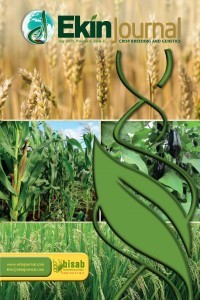Determination of morphological variability of local pea genotypes
Determination of morphological variability of local pea genotypes
___
- Akçin A (1988). Yemeklik Dane Baklagiller. Selçuk Üniversitesi Yayınları: 43, Ziraat Fakültesi Yayınları: 8, Konya.
- Alan Ö and Geren H (2012). Bezelye’de (Pisum sativum L.) farklı ekim zamanlarının tane verimi ve diğer bazı tarımsal özellikler üzerine etkisi. Ege Üniversitesi Ziraat Fakültesi Dergisi 49 (2): 127-134.
- Bhatt M and Chanda SV (2003). Prediction of leaf area in Phaseolus vulgaris by nondestructive method. Bulg J Plant Physiol 29 (1-2): 96-100.
- Brown JS (1991) Principal component and cluster analysis of cotton cultivar variability a cross the U.S. cotton belt. Crop Sci. 31: 915-922.
- Demirci G and Ünver S (2005). Ankara koşullarında bezelyede (Pisum sativum L.) farklı ekim zamanlarının verim ve verim öğelerine etkileri. Anadolu J of AARI 15 (1): 49-60.
- FAOSTAT (2012). http://faostat.fao.org/site/567/ DesktopDefault.aspx?PageID=567#ancor. Accessed 30 October 2013.
- Garnier E, Shipley B, Roumet C and Laurent G (2001). A standardized protocol for the determination of specific leaf area and leaf dry matter content. Functional Ecology 15: 688-695.
- Gülümser A, Seyis F and Bozoğlu H (1994). Samsun ekolojik şartlarında kışlık ve yazlık olarak ekilen bezelye çeşitlerinin konservecilik özellikleri ile tane veriminin tespiti. E.Ü.Z.F. Tarla Bitkileri Bölümü Tarla Bitkileri Bilim Derneği TUBİTAK ve ÜSİGEM. Tarla Bitkileri Kongresi, 25-29 Nisan 1994 Cilt I Agronomi Bildirileri, İzmir, 87-90.
- Gülümser A, Bozoğlu H and Peşken E (2008). Yemeklik Baklagiller. Ondokuz Mayıs Üniversitesi Ziraat Fakültesi, Ders Kitabı No:27, 2. Baskı, Samsun.
- Karayel R and Bozoğlu H (2008). Türkiye’nin farklı bölgelerinden toplanan yerel bezelye polulasyonunun bazı agronomik özellikleri. OMÜ Zir Fak Dergisi 23 (1): 32-38.
- Karayel R and Bozoğlu H (2009). Bezelye (Pisum sativum L.) genotiplerinde korelasyon ve path analizi. Türkiye VIII. Tarla Bitkileri Kongresi, Cilt II, Poster Bildiriler, 19-22 Ekim 2009, Hatay. 712-716.
- Kaya M (2000). Winner bezelye (Pisum sativum L.) çeşidinde farklı aşılama yöntemleri, azotlu gübre dozları ile ekim zamanlarının verim ve verim öğelerine etkisi. Doktora Tezi, Ankara Üniversitesi, Fen Bilimleri Enstitüsü, Ankara. Mohammadi SA and Prasanna BM (2003). Analysis of genetic diversity in crop plants-salient statistical tools and considerations. Crop Science 43: 1235-1248
- Öz M and Karasu A (2010). Bazı bezelye (Pisum sativum L.) çeşitlerinin tohum verimi ve verim kompenentlerinin belirlenmesi. Süleyman Demirel Üniversitesi Ziraat Fakültesi Dergisi 5 (1): 44-49.
- Perez MD, Chambers SJ, Bacon JR, Lambert N, Hedley CL and Wang TL (1993). Seed protein content and composition of near-isogenic and induced mutant pea lines. Seed Science Research 3: 187-194.
- Rencher AC (1995). Methods of Multivariate Analysis. John Willey&Sons Inc.
- Sözen Ö, Özçelik H and Bozoğlu H (2013). Determination of morphological variability at domestic bean (Phaseolus vulgaris L.) populations collected from west black sea region. Soil-Water Journal 2(2): 1543-1552.
- Timuroğlu KA, Genç A and Altınok S (2004). Ankara koşullarında yem bezelyesi hatlarında yem ve tane verimleri. Ankara Üniversitesi Ziraat Fakültesi Tarım Bilimleri Dergisi 10(4): 457-461.
- Tiwari SK, Sing HL, Kumar R, Nigam HK and Singh AP (2001). Apostportem of selection parameters in pea (Pisum sativum L.). Research on Crops 2(2): 237- 242.
- Toğay N, Toğay Y, Erman M and Yıldırım B (2006). Kışlık iki bezelye hattı (Pisum sativum ssp. arvense L.)’nda farklı bitki sıklıklarının bazı tarımsal özellikler üzerine etkisi. Yüzüncü Yıl Üniversitesi Ziraat Fakültesi Tarım Bilimleri Dergisi (J. Agric. Sci.) 16 (2): 97-103.
- URL (2003). Protokol for Ditsinctness, Uniformity and Stability Tests, Pea (Pisum sativum L. sensu lato), Europan Union, Communıty Plant Variety Office.
- ISSN: 2149-1275
- Yayın Aralığı: Yılda 2 Sayı
- Başlangıç: 2015
- Yayıncı: Bitki Islahçıları Alt Birliği
Effect of growth regulators on tissue culture parameters in rice (Oryza sativa L.)
Berk BENLİOĞLU, Duygu Ege TUNA, Melahat Avcı BİRSİN, Ahmet Murat OZGEN
Development of BAC-End based simple sequence repeat (SSR) markers in apple
Elmira Ziya MOTALEBİPOUR, Nergiz COBAN, Mortaza KHODAEİAMİNJAN, Murat GUNEY, Serif OZONGUN, Nilgun ATAY, Salih KAFKAS
Meirman G. TULENDİNOVOVİCH, Yerzhanova S. TANYRBERGENOVNA
A new semidwarf cultivar “Uruq” developed from irradiated stored seeds of soft wheat cv. “Inia-66”
Genotypes X environment interaction effect on nutritional quality of sorghum lines in Indonesia
- TRİKOESOEMANİNGTYAS, Desta WİRNAS, Didy SOPANDİE, Tesfaye TESSO
KASIB spring common wheat genotype identification on glutenin and gliadin subunits
Aigul ABUGALİEVA, Alexei MORGOUNOV, Javier Roberto PENA, Nina VOLKOVİNSKAYA, Timur SAVİN
Determination of morphological variability of local pea genotypes
Reyhan KARAYEL, Hatice BOZOGLU
Screening of new varieties of sainfoin with a high potential nitrogen fixation
Galina N. CHURKİNA, Evgeniya P. SALACHENOK, Galiya K. AKHMETOVA
